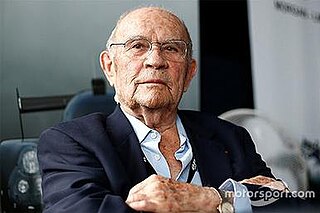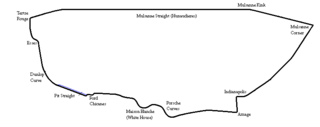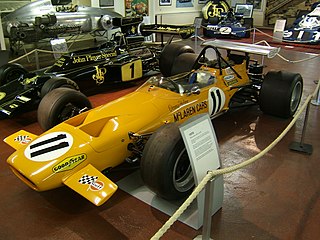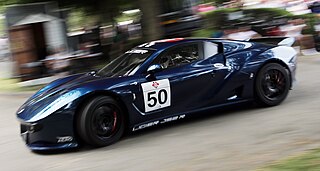
Cosworth is a British automotive engineering company founded in London in 1958, specialising in high-performance internal combustion engines, powertrain, and electronics for automobile racing (motorsport) and mainstream automotive industries. Cosworth is based in Northampton, England, with facilities in Cottenham, England, Silverstone, England, and Indianapolis, IN, US.

The DFV is an internal combustion engine that was originally produced by Cosworth for Formula One motor racing. The name is an abbreviation of Double Four Valve, the engine being a V8 development of the earlier four-cylinder FVA, which had four valves per cylinder.

Guy Camille Ligier was a French racing driver and team owner. He maintained many varied and successful careers over the course of his life, including rugby player, butcher, racing driver and Formula One team owner.

Gitanes is a French brand of cigarettes, owned and manufactured by Imperial Tobacco following their acquisition of Altadis in January 2008, having been owned by SEITA before that.

The Mirage Lightweight Racing Car was a family of race cars built by J.W. Automotive Engineereing (JWAE) at Slough in England, initially to compete in international sports car races in the colours of the Gulf Oil Corporation.

The 1975 24 Hours of Le Mans was the 43rd Grand Prix of Endurance, and took place on 14 and 15 June 1975. Colloquially called the “Le Mans Economy Run”, stringent refuelling regulations were put in place. Unable to match the requisite 7mpg fuel economy the manufacturer teams from Ferrari, Alfa Romeo withdrew and Matra had retired from the sport at the end of 1974. Therefore, this only left Gulf and Ligier as front-running works-teams.

The Lotus 16 was the second single-seat racing car designed by Colin Chapman, and was built by his Lotus Cars manufacturing company for the Team Lotus racing squad. The Lotus 16 was constructed to compete in both the Formula One and Formula Two categories, and was the first Lotus car to be constructed for Formula One competition. Its design carried over many technological features of the first Lotus single-seater, the Lotus 12, as well as incorporating ideas which Chapman had been developing while working on the Vanwall racing cars. Indeed, such was the visual similarity between the Vanwall and Lotus 16 designs that the Lotus was often dubbed the "mini Vanwall" by the contemporary motor sport press. Although the Lotus 16 only scored five Formula One World Championship points in the three seasons during which it was used, its raw pace pointed the way for its more successful successors, the Lotus 18 and 21.

The McLaren M14A is a Formula One racing car built and raced by McLaren in the 1970 and 1971 World Championship. A later extension, the M14D featured an Alfa Romeo V8 engine.

Équipe Ligier is a motorsport team, best known for its Formula One team that operated from 1976 to 1996. The team was founded in 1968 by former French rugby union player Guy Ligier as a sports car manufacturer.

The Chevron B23 is a Group 5 sports prototype race car, designed, developed and built by British manufacturer Chevron, in 1973. Over its racing career, spanning 12 years, it won a total of 12 races, scored 41 podium finishes, and clinched 2 pole positions. It was powered by a naturally-aspirated 3.0 L (180 cu in) Ford-Cosworth DFV Formula One engine, producing 398 hp (297 kW).

The Matra Sports V12 engine is a family of automotive internal combustion engines built for Formula One (F1) and sports car endurance racing. Cars powered by versions of the engine won at the 24 Hours of Le Mans in 1972, 1973, and 1974, and gave Matra the World Championship for Makes title in 1973 and 1974. The Matra Sports V12 is also remembered for its distinctive sound.

The Ligier JS2 is a mid-engined sports coupé that was built by Ligier in the French commune of Abrest near Vichy in the department of Allier between 1971 and 1975. Road-going and competition versions were built.
The Ligier JS1 is a sports-racing car that debuted in 1969 and was built by Automobiles Ligier. The car competed in various sportscar racing events during the 1969 and 1970 seasons.

The Ligier JS2 R is a GT racing car manufactured by French automaker Ligier. Designed solely for track use, the car is an homage to the original Ligier JS2 introduced in 1972.
Weslake V12 engine refers to two families of naturally-aspirated, four-stroke, 60° V12 racing engines, both initially designed by Weslake and produced and developed by Weslake and others between 1966 and 1992. The engines were raced in Formula One (F1) and sports car endurance racing, while various plans for Weslake V12-powered road cars all came to nothing.

The Rondeau M378 is a Group 6 sports prototype race car, designed, developed and built by Automobiles Jean Rondeau, in 1978, and was their second car. It competed in one World Sportscar Championship sports car racing event; the 1978 24 Hours of Le Mans. It was driven by Bernard Darniche, Jacky Haran, Jean Rondeau, and its best result was a 9th-place finish at that year's event. It was powered by a 3.0 L (180 cu in), 460 hp (340 kW), Ford-Cosworth DFV V8 Formula One engine.The chassis is an aluminum-reinforced steel spaceframe, covered in a fiberglass panel body. This drove the rear wheels through a Hewland 5-speed manual transmission. This meant it was very light, with the total weight coming to 760 kg (1,680 lb).

The Inaltéra GTP is a Group 6 sports prototype race car, designed, developed and built by Automobiles Jean Rondeau in 1976.

The Lola T210, and its evolution, the Lola T212, are Group 6 sports prototype race cars, designed, developed and built by British manufacturer Lola, for the newly created European 2-Litre sports car racing championship, in 1970.

The Lola T280, and its evolutions, the Lola T282, Lola T284, and Lola T286, are a series of 3-liter Group 5 sports prototype race cars, designed by Eric Broadley, John Barnard, and Patrick Head, and developed and built by British manufacturer and constructor Lola, for World Sportscar Championship sports car racing, between 1972 and 1976.
Michel Têtu, born 6 August 1941, is a French engineer best known as a designer of racing sports cars and Formula 1 (F1) cars for marques such as Ligier, Alfa Romeo, and Renault.
















